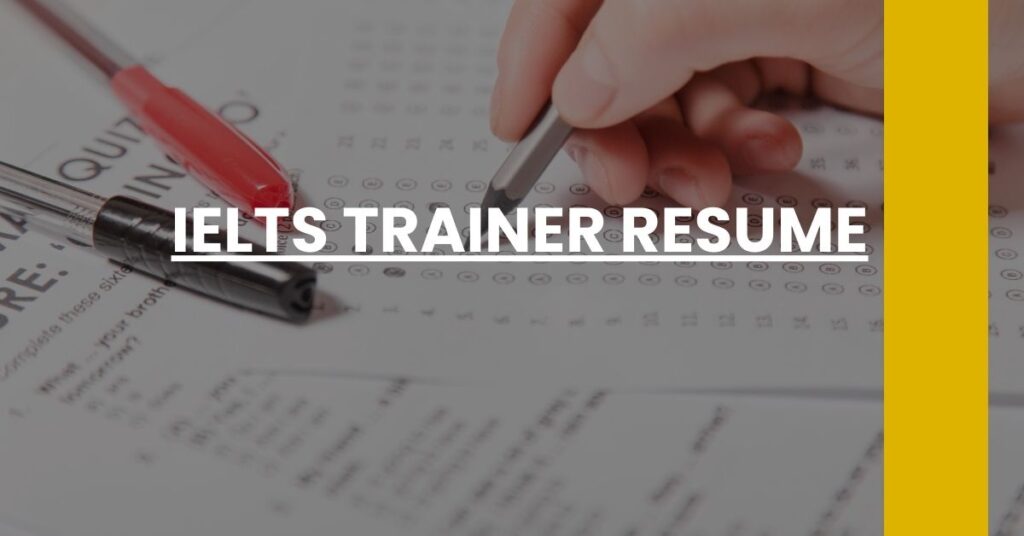Craft a standout IELTS trainer resume and set yourself apart in the competitive teaching market.
- Tailored Content: Engage with specific IELTS training insights that resonate with employers.
- Impactful Structure: Utilize an organized format to highlight your teaching successes.
- Skillful Presentation: Showcase your qualifications with polished professional design.
Elevate your career with a precisely curated IELTS trainer resume.
- Understanding the Role of an IELTS Trainer
- Capturing the Essentials: What to Include
- The Power of a Strong Objective or Summary Statement
- Highlighting Your Work Experience Effectively
- Education and Certifications: Standing Out as a Qualified Instructor
- IELTS-Specific Skills to Showcase
- Tailoring Your Resume for the IELTS Niche
- Crafting the Perfect Cover Letter to Complement Your Resume
- Leveraging References and Recommendations
- Resume Formatting and Design Tips
- Conclusion: Landing Your Dream IELTS Training Role
Understanding the Role of an IELTS Trainer
Before you set out to craft your IELTS trainer resume, it’s crucial to grasp the multifaceted nature of the role you’re aspiring to fill. As an IELTS trainer, your primary duty is to prepare candidates for the International English Language Testing System (IELTS) examination, which assesses the English language proficiency of non-native speakers.
Responsibilities of an IELTS Trainer
- Assessment of Students’ Abilities: Assess the speaking, listening, writing, and reading skills of students to gauge their proficiency levels.
- Curriculum Design: Develop and implement effective test preparation strategies tailored to meet students’ individual learning needs.
- Instructional Delivery: Conduct sessions in various modes, such as one-on-one coaching, group lessons, and classroom teaching.
- Feedback and Evaluation: Provide constructive feedback to help students improve their performance and achieve higher scores.
Understanding the responsibilities, you should articulate your experiences in a way that resonates with your potential employer. Reflect on how you’ve effectively carried out similar tasks in the past and how they’ve honed your teaching skills — these are the focal points of your resume.
Capturing the Essentials: What to Include
When you begin writing your IELTS trainer resume, think of it as your personal highlight reel packaged in a way that speaks directly to the needs of the hiring institution. Here’s what to include to make an impact:
- Contact Information: Ensure this is updated and correct. This is how prospective employers will reach you.
- Professional Summary: A concise, powerful statement that encapsulates your teaching philosophy and career highlights.
- Experience: Detail your employment history, focusing on roles that have prepared you for IELTS training.
- Education: Outline your educational background, being sure to include any degrees related to language or education.
- Certifications: List any relevant certifications, such as TESOL or CELTA, that lend credibility to your expertise as an IELTS trainer.
Each section must be crafted with precision, ensuring that key information is conveyed clearly and concisely. The order and depth you give to each section can be a game-changer, making it vital that you prioritize the information strategically.
The Power of a Strong Objective or Summary Statement
Your resume is more than a document — it’s a narrative. The objective or summary statement at the top of your resume sets the stage for this narrative, and here’s where you get to shine.
- Emphasize Your Unique Value: What sets you apart from other applicants? Whether it’s your years of experience or a distinctive teaching style, highlight what makes you unique.
- Tailor It to the Role: Adjust your language to echo the keywords and priorities outlined in the job description.
Remember, this isn’t just a blurb; it’s your career distilled into a potent introduction, designed to capture attention and make a memorable first impression.
Highlighting Your Work Experience Effectively
Tailoring Your Experience
A well-articulated experience section is the backbone of a compelling IELTS trainer resume. Going beyond a mere list of job titles, it needs to convey the breadth and depth of your professional journey.
- Describe Achievements, Not Just Duties: Illustrate how your work has positively impacted your previous organizations or students’ outcomes.
- Use Strong Action Verbs: Words like ‘facilitated,’ ‘implemented,’ and ‘enhanced’ showcase your active role in achieving results.
- Quantify Your Success: Whenever possible, use numbers to add weight to your achievements, like “improved student test scores by 20%.”
The focus here is on storytelling through data and vibrant descriptions that paint a picture of a proactive and effective educator.
Education and Certifications: Standing Out as a Qualified Instructor
Your educational background and certifications form the bedrock of your qualifications as an IELTS trainer. Education should not only be a testament to your knowledge but also reflect your commitment to teaching English as a second language.
- Highlight Relevant Degrees: Degrees in English, Linguistics, Education, or TESOL are directly relevant and should be prominently featured.
- Showcase Your Certifications: If you have taken additional certifications like IELTS examiner training or other ESL endorsements, they demonstrate your specialized knowledge and commitment to the field.
Certifications play a pivotal role, especially if you’re relatively new to the profession. They serve as evidence of your knowledge and expertise, making you a strong candidate, even in a pool seasoned with experienced professionals.
IELTS-Specific Skills to Showcase
As a seasoned IELTS trainer, you’re well aware that your resume should exemplify a unique set of skills tailored to the IELTS niche. It’s these nitty-gritty details that distinguish an experienced instructor from a novice.
Core IELTS Training Competencies
Display a command over skills that directly impact your ability to train IELTS candidates efficiently:
- Test Preparation Mastery: Deep familiarity with IELTS test formats and question types is non-negotiable. Showcasing your expertise in crafting strategies tailored for each section of the test will set you apart.
- Targeted Curriculum Development: Highlight your proficiency in creating bespoke training materials and exercises that address individual learners’ needs.
Analytical and Feedback Skills
These are crucial in understanding candidate performance and guiding them towards improvement:
- Candidate Performance Analysis: Articulate how you assess and track student progress, using analytical insights to tweak your training approaches.
- Constructive Feedback Delivery: Your ability to provide thoughtful, actionable feedback helps students refine their skills and confidence as English users.
Soft Skills and Attributes
Often overlooked, these play an integral role in stimulating a conducive learning environment:
- Exceptional Communication: This isn’t just about speaking English well; it’s about being able to explain complex concepts in an accessible way.
- Patience and Empathy: Being an IELTS trainer involves more than just imparting knowledge; it’s also about understanding the challenges learners face and supporting them through their journey.
Ensure these skills are not just listed, but woven into your resume’s narrative to demonstrate you’re a trainer with a results-oriented ethos.
Tailoring Your Resume for the IELTS Niche
Your IELTS trainer resume should read as though it was crafted for the very role you’re applying for, resonating with the specific nuances of the job description at hand.
Customizing with Keywords
Use strategically placed keywords that mirror the job listing to pass through Applicant Tracking Systems (ATS) with flying colors:
- Integrate key phrases from the job description, such as “IELTS curriculum design” or “student assessment”, into your experience and skills sections.
- Mention any IELTS-specific training you’ve received; this highlights your specialization and dedication to the niche.
Aligning with Job Requirements
Shape your resume to make it clear that you’re not just an English language teacher, but an IELTS expert:
- Relevance Over Quantity: Prioritize experiences and skills that directly align with the key responsibilities of an IELTS trainer.
- Showcase Your Results: Employers want to see outcomes, so include success stories where you’ve helped students achieve high IELTS scores.
Customizing your resume for each application can be time-consuming, but it’s an investment that can significantly increase your chances of landing the job.
Crafting the Perfect Cover Letter to Complement Your Resume
While your resume is there to outline your experience and qualifications, your cover letter is your chance to tell the story behind the bullet points.
- Connect with the Employer: Start by expressing your enthusiasm for the role and explaining why you’re particularly interested in their institution.
- Highlight Your Most Relevant Experience: Elevate key parts of your resume with anecdotes or deeper explanations of your most relevant work.
Consider your cover letter an opportunity to give context to your resume, providing a clear picture of your capabilities and how you can add value to the organization.
Leveraging References and Recommendations
In a crowded field of candidates, a robust set of references can be just the edge you need. These validations of your expertise and work ethic can be incredibly convincing.
- Select Relevant Referees: Choose former employers or colleagues who have directly observed your IELTS training abilities.
- Prep Your References: Ensure they are willing to vouch for you and are aware of the jobs you are applying for so they can tailor their recommendations accordingly.
Support your resume with the credibility that only someone else’s endorsement can bring. A positive reference can be the deciding factor in securing your next IELTS training position.
Resume Formatting and Design Tips
First impressions are everything, and the visual layout of your IELTS trainer resume can significantly impact the impression you make on potential employers.
Principles of Resume Design
A good resume is not just about the content; it’s also about presentation:
- White Space is Your Friend: Allow your content room to breathe with adequate spacing. It guides the reader’s eyes and prevents information overload.
- Choose a Readable Font: Stick to professional fonts like Arial or Times New Roman in a size that’s easy on the eyes.
Remember, simplicity is key. A cluttered resume may distract from the important content you’re trying to highlight.
Conclusion: Landing Your Dream IELTS Training Role
Everything about your IELTS trainer resume should testify to your expertise, your instructional finesse, and your dedication to students’ language development. It’s not just about listing your past roles; it’s about conveying the impact you’ve had and the value you bring. Consider your resume a personal marketing brochure, where every line and bullet point is a pitch for why you’re the best candidate for the IELTS trainer role. By focusing on the detailed guidance above, you can craft a resume that not only looks professional but also encapsulates your deep understanding of the IELTS examination and your unique teaching methodologies. Take the time to perfect your resume, and watch as the doors to your dream opportunities swing wide open.
IELTS Trainer Resume Guide: Expert tips for crafting resumes that highlight your teaching skills and improve your job prospects.

